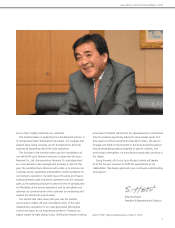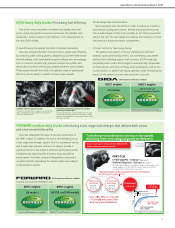Isuzu 2010 Annual Report Download - page 17
Download and view the complete annual report
Please find page 17 of the 2010 Isuzu annual report below. You can navigate through the pages in the report by either clicking on the pages listed below, or by using the keyword search tool below to find specific information within the annual report.
15
Isuzu Motors Limited Annual Report 2010
3. Operating income
Operating income in fiscal 2010 was ¥11.0 billion, down 49.1%
from a year earlier.
Fixed cost reduction efforts contributed ¥41.2 billion, while cost
fluctuations (steel, oil prices and etc) and material cost reductions
added ¥18.1 billion and ¥13.0 billion, respectively. Offsetting these
were ¥80.7 billion in sales and model mix fluctuations, and ¥2.3
billion in exchange rate fluctuations caused by the strength of the
yen.
As a result, Isuzu’s operating margin deteriorated to 1.0%,
compared to 1.5% for the previous year.
An analysis by segment is available in “14. Segment
Information” under “Notes to Consolidated Financial Statements.”
4. Non-operating gains/losses
In fiscal 2010, Isuzu posted a non-operating gain of ¥0.3 billion,
an improvement of ¥6.7 billion from the previous year.
Equity-method investment income fell ¥0.7 billion to ¥4.2 bil-
lion, primarily as a result of reduced profitability at Japanese parts
manufacturers to which equity-method accounting is applied.
The accumulation of additional interest-bearing debt resulted
in a net interest (interest and dividends income minus interest
expenses) loss of ¥4.5 billion, a deterioration of ¥2.1 billion com-
pared to the previous year. This was offset by a foreign exchange
gain of ¥1.7 billion (compared to a loss of ¥3.9 billion in the pre-
vious year) for an improvement of ¥5.7 billion compared to the
previous year.
5. Extraordinary gains/losses
In fiscal 2009, Isuzu posted an extraordinary loss of ¥3.7 billion
due to such contributing factors as loss on disposal of noncurrent
assets, provision of allowance for doubtful accounts, and loss on
the valuation of inventories. In fiscal 2010, the extraordinary loss
improved ¥1.5 billion to ¥2.2 billion, reflecting extraordinary losses
including loss on disposal of noncurrent assets, impairment loss,
and environmental expenses, and extraordinary income of com-
pensation income for expropriation.
6. Taxes
Isuzu’s net tax expense in fiscal 2009 including current income
taxes and deferred income taxes was ¥32.9 billion. In fiscal 2010,
the net tax income was ¥4.1 billion due to the effect of deferred
tax assets.
7. Minority interests
Minority interests consist primarily of profits returned to the
minority shareholders of Isuzu’s locally incorporated subsidiaries
in the ASEAN region and North America and its Japanese parts
manufacturers. Minority interests in fiscal 2010 decreased to ¥4.9
billion, compared to ¥5.3 billion in fiscal 2009.
8. Net income
The Group posted a net profit of ¥8.4 billion in fiscal 2010, an
improvement of ¥35.2 billion from the previous year. Net income
per share came to ¥4.96.
The following provides an analysis of the financial condition and
results of operation in fiscal 2010. The following information
contains forward-looking statements that reflect the judgment of
management as of June 29, 2010.
(1) Significant accounting policies and estimates
The consolidated financial statements of the Isuzu Group are
prepared in accordance with generally accepted accounting princi-
ples of Japan. In the preparation of these statements, the amounts
recorded for items including allowance for doubtful accounts,
inventory, investments, income taxes, retirement benefits, and
provision for product warranties are estimates that reflect the
judgment of management. Due to the uncertain nature of esti-
mates, in some cases actual results may vary from initial estimates,
and this may have a negative impact on business results.
(2) Results of operations
1. Overview of fiscal 2010
Profitability at all Group companies improved despite the
impact of a strong yen and a slowdown in sales during the first
half of the fiscal year thanks to a rapid recovery in domestic as
well as overseas sales, particularly in the ASEAN region, and
group-wide efforts to improve the bottom line. Results of opera-
tion in fiscal 2010 were sales of ¥1,080.9 billion (down 24.1%
from the previous year), operating income of ¥11.0 billion (down
49.1% from the previous year), ordinary income of ¥11.3 billion
(down 25.2% from the previous year), and net income of ¥8.4 bil-
lion (compared to a loss of ¥26.8 billion in the previous year).
2. Sales
In fiscal 2010, Isuzu’s consolidated-basis sales fell 24.1% from
the previous year to ¥1,080.9 billion.
In the domestic commercial vehicle market, Isuzu extended
its high market share through the introduction of products with
superior fuel efficiency and economy, capturing 32.9% of the
medium-duty and heavy-duty trucks market (up 3.2% from the
previous year) and 40.0% of the light-duty (2-3 ton) truck market
(up 0.9% from the previous year). However, demand for medium-
duty and heavy-duty trucks declined significantly to 41,622 (down
33.9% from the previous year), as did demand for light-duty
trucks at 48,859 (down 30.3% from the previous year), reflect-
ing the economic slowdown and continuing the trend established
during the previous consolidated fiscal year. As a result, domestic
sales fell 18.9% to ¥432.9 billion.
Sales in Asia dropped 4.5% from the previous year to ¥352.5
billion. Key factors included a decline in demand despite the
Group’s high 39% market share in the Thai market.
North American sales fell 37.3% to ¥52.7 billion, reflecting the
impact of the slowdown in the U.S. economy.
Sales to other regions fell 44.5% to ¥242.6 billion, reflecting
the delayed recovery in Europe and the Middle East.
An analysis by segment is available in “14. Segment
Information” under “Notes to Consolidated Financial Statements.”
Management’s Discussion and Analysis of Financial Condition and Results of Operation
























